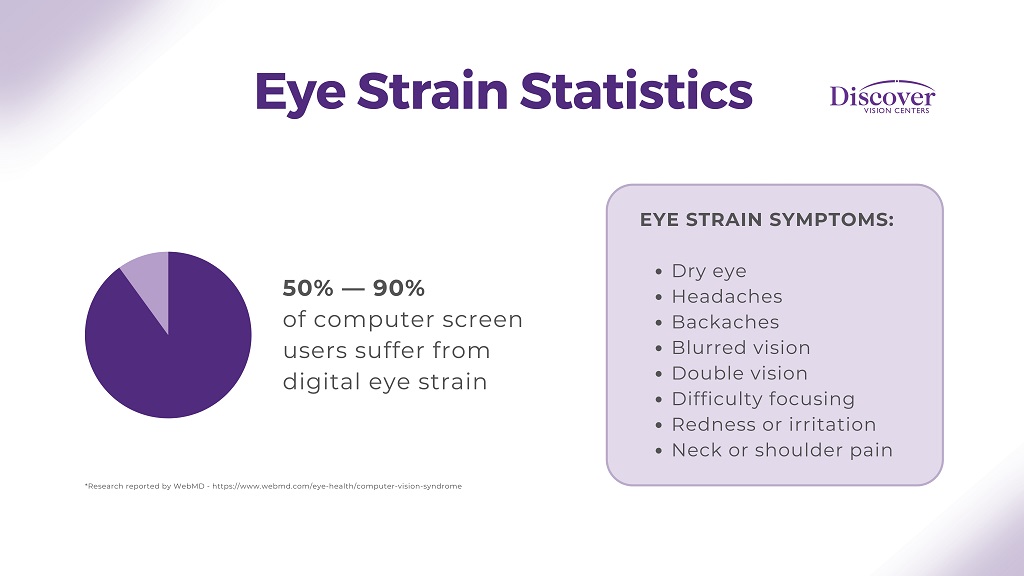
Updated: March 20, 2024

Embarking on the transformative journey of LASIK surgery opens a new chapter of visual clarity and freedom from corrective lenses. As you anticipate the remarkable changes in your eyesight, it’s crucial to understand the post-LASIK computer use dynamics. In this guide, we’ll delve into essential insights, tips, and precautions to ensure a seamless transition to computer activities after LASIK. Whether you’re a professional glued to the screen or a casual user, this guide will empower you to navigate the digital realm effortlessly. Learn more about LASIK surgery at Discover Vision.
Prolonged computer use has become unavoidable in our modern lives, but understanding its effects on eye health is imperative. Staring at screens for extended periods can lead to a range of ocular issues collectively known as Computer Vision Syndrome (CVS). The eyes are strained as they continuously focus on pixels, leading to symptoms such as eyestrain, headaches, and blurred vision. It should also be understood that many of the same issues involving computer screens are also present with usage of smartphone screen time.
One significant concern is the reduced blink rate during computer use, causing insufficient moisture distribution across the eyes. This often results in dry eyes, a condition where the eyes lack adequate lubrication. Dry eyes can be particularly bothersome, causing discomfort, redness, and even affecting vision. To alleviate this, adopting the 20-20-20 rule — looking at something 20 feet away for 20 seconds every 20 minutes — can help alleviate eye strain.
Moreover, the blue light emitted by screens can disrupt circadian rhythms and potentially lead to sleep disturbances. Some people find that incorporating blue light filters on screens or using specialized computer glasses especially in the hours leading up to bedtime improve their sleep quality.
Understanding these effects is crucial for anyone who spends substantial time in front of screens. For those experiencing persistent discomfort, seeking professional advice, including exploring dry eye treatment options, is essential. Discover more about dry eye treatment at Discover Vision, where tailored solutions can address and alleviate eye discomfort associated with prolonged computer use.

In the realm of LASIK surgery recovery, the impact of using a computer during the healing process is a crucial consideration. Engaging in computer activities post-LASIK requires a delicate balance, as the eyes undergo a transformative recovery period. Understanding the dynamics of using a computer after LASIK and its potential effects on the recovery process is essential for optimal outcomes.
LASIK surgery has a quick recovery and most people who work computer-based jobs can return to work very quickly. But, because many jobs and modern life demand prolonged computer usage for 6-10 hours per day, steps must be taken to avoid Computer Vision Syndrome (CVS) during LASIK recovery. Experiencing some visual glare while working on the computer is normal after surgery and will gradually recover over the first 2-3 weeks.
Using a computer after LASIK surgery may also contribute to some degree of eye dryness, a common postoperative symptom. Many patients find that using preservative-free artificial tears as recommended by your LASIK surgeon, can help lubricate the eyes and improve vision and comfort for the first 3-4 weeks following surgery. When possible, paying attention to the eye’s signals that a break is needed, such as irritation, dryness, or eye strain, can improve and speed up recovery.
Navigating the delicate balance of using a computer after LASIK requires a personalized approach, taking into account individual healing variations.

Embarking on a post-LASIK journey involves thoughtful consideration of screen use to safeguard your eyes during the recovery process. Ensuring a seamless transition to computer activities requires adopting practical tips that prioritize eye health. Here are key insights to protect your eyes and maximize comfort while looking at screens after LASIK.
In the realm of screen use, the simple act of blinking often gets overlooked. However, consistent blinking is crucial post-LASIK. It helps distribute natural tears across the eyes, preventing dryness and discomfort. During screen use, the blink rate decreases dramatically. Remember to take breaks to consciously blink at regular intervals, especially during prolonged screen use, to maintain optimal eye moisture.
Lubricating eye drops, commonly known as artificial tears, are your allies in combating post-LASIK dryness. Use preservative-free artificial tears as recommended by your LASIK surgeon. Applying these drops at regular intervals, sometimes as much as once an hour during the first few weeks of recovery, can help keep your eyes adequately moisturized, reducing the risk of discomfort associated with prolonged screen use.
Incorporate simple eye exercises into your routine to alleviate strain caused by extended screen time. Gentle exercises, such as focusing on a distant object for a few moments or practicing the 20-20-20 rule, can enhance eye flexibility and reduce fatigue. Explore additional eye exercises for comprehensive eye health on the Discover Vision Blog to complement your post-LASIK care.

Maintain a safe and comfortable distance between your eyes and the screen to prevent unnecessary strain. Position your computer at eye level and ensure a comfortable distance, usually around arms length, to reduce eye fatigue while recovering from LASIK.
Ergonomics play a pivotal role in eye health during screen use. Ensure your workstation is set up to promote a comfortable posture. Position your chair, monitor, and keyboard to avoid awkward angles, minimizing the risk of strain on your eyes, neck, and shoulders. Try to position your preservative-free artificial tears close by also.
The importance of adequate sleep cannot be overstated, especially during LASIK recovery. Quality sleep contributes to overall eye health and helps in the healing process. Prioritize a consistent sleep schedule, providing your eyes the essential rest they need to recover effectively.
By incorporating these practical tips into your post-LASIK routine, you can protect your eyes, enhance comfort during screen use, and optimize the benefits of LASIK surgery.
Discover Vision brings you closer to experienced eye surgeons in Kansas City, ensuring personalized and expert LASIK care. Our skilled professionals are dedicated to enhancing your vision and guiding you through a seamless LASIK experience. If you’re ready to take the next step towards visual freedom, contact our Kansas City LASIK surgeons today. Schedule a free LASIK consultation and embark on the journey to clearer vision. Connect with us here and experience the expertise of our renowned eye surgeons.

After PRK surgery, vision fluctuates significantly over the first 5-7 days and many experience eye watering and sensitivity. During these symptoms, it is best to limit computer usage to essentials and use frequent preservative-free artificial tears. If your eyes feel strained or fatigued during computer use, take breaks, and consider reducing screen time until your eyes fully adjust. While initial computer use may be limited, gradual resumption is encouraged after the first week.
Following cataract surgery, it’s crucial to ease back into computer use gradually. Expect temporary blurriness or discomfort, but if these persist, consult your surgeon. Adhere to recommended breaks, keep your screen well-lit, and prioritize overall eye comfort by using artificial tears as needed during the recovery process.
After LASIK, it’s advisable to wait a few days before diving into extensive video game sessions as the eyes may be dry during initial healing. Be mindful of screen brightness, take breaks, and use frequent preservative-free artificial tears. If discomfort persists, consult your LASIK surgeon for personalized guidance.
Using your phone after LASIK is generally fine but you may need more frequent breaks. Follow screen brightness guidelines, take breaks, and use frequent preservative-free artificial tears. If eye discomfort arises, reduce usage and consult your LASIK surgeon for personalized advice during the recovery period.